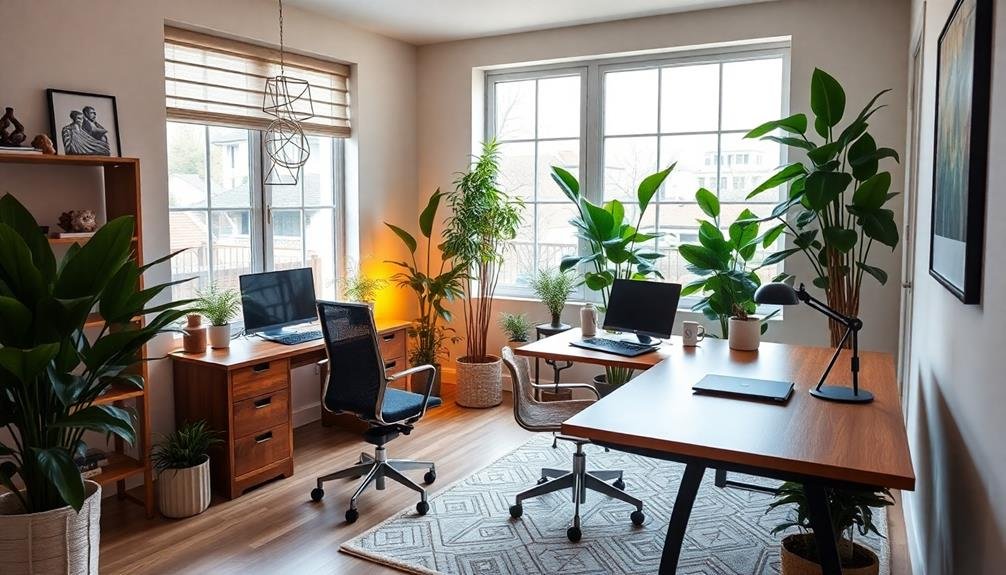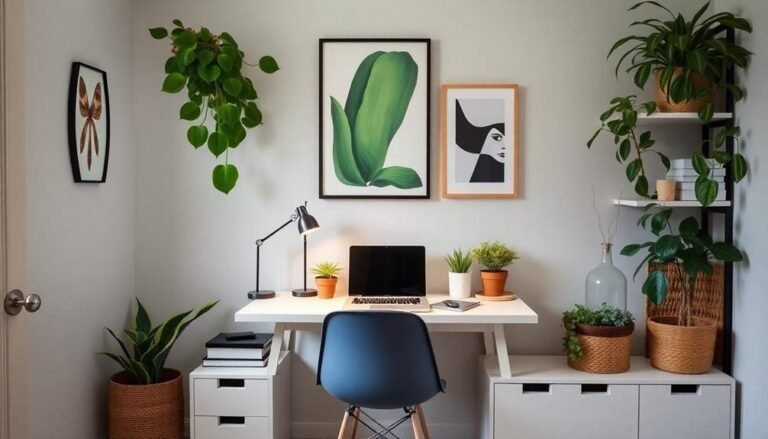To choose the right desk for your home office setup, start by evaluating your space—think about size, shape, and how the desk fits with existing furniture. Identify your work needs, whether it's computer-based tasks or paperwork, and consider storage options. Select a style that aligns with your personal taste and enhances productivity, whether it's modern or traditional. Prioritize materials for durability, such as solid wood or metal, and make certain ergonomic features promote comfort, like adjustable height and proper screen positioning. This thoughtful approach can create a more effective workspace, and exploring options further will reveal even more tips to enhance your setup.
Assess Your Space

Before you plunge into choosing a desk, take a good look at your space. Evaluating your area is essential; it sets the foundation for your desk selection. Consider the room's size, shape, and existing furniture. If your home office is small, a compact desk might maximize your workspace without feeling cramped. Conversely, if you have ample room, a larger desk could offer more functionality and aesthetic appeal. Additionally, consider options like standing desks to promote better posture and energy levels during your workday.
Next, pay attention to your room's layout. Is there enough natural light? Positioning your desk near a window can create a pleasant working atmosphere. Also, think about the flow of the room. You don't want to block pathways or create unnecessary obstacles.
Don't forget about storage needs. If you already have shelving or cabinets, you may want a desk that complements those pieces. Imagine how your chosen desk will fit into the overall design of your office, ensuring everything feels cohesive.
Lastly, take note of electrical outlets. You'll want easy access to power for your devices, so plan accordingly. By evaluating your space thoroughly, you'll be well-equipped to find a desk that enhances your home office experience.
Determine Your Needs

Identifying your specific needs is essential when selecting a desk for your home office. Start by considering the type of work you'll be doing. For instance, if you're working primarily on a computer, you might need a desk that accommodates multiple monitors or has a built-in keyboard tray. A well-designed desk can also enhance your overall workspace aesthetics, making it more inviting and conducive to productivity. On the other hand, if your work involves a lot of paperwork, you'll want a larger surface area to spread out documents.
Next, think about your storage requirements. Do you need drawers for files or shelves for books and supplies? A desk with integrated storage options can help keep your workspace organized and clutter-free; elevate your workspace by choosing a stylish desk that meets your storage needs. Additionally, consider your preferred level of comfort. If you plan to spend long hours at your desk, an adjustable height option or a desk with ergonomic features might be beneficial.
Lastly, reflect on your work habits. Are you someone who likes to take notes by hand or prefer digital tools? This can influence your choice of desk accessories and layout. By pinpointing your needs, you'll set a solid foundation for selecting a desk that enhances your productivity and suits your personal style.
Choose the Right Style

Once you've assessed your needs, it's time to think about style. The desk you choose should reflect not only your personal taste but also the overall aesthetic of your home office. To elevate your workspace, consider incorporating stylish decor elements that complement your desk choice. Whether you prefer a modern, minimalist look or a more traditional, ornate design, your desk should seamlessly integrate into your workspace. For instance, if you lean towards a contemporary style, consider a sleek, glass-top desk that complements clean lines and neutral colors. On the other hand, if you appreciate a classic feel, a wooden desk with intricate detailing might be more your speed.
Additionally, think about the size and shape of your desk. A corner desk can maximize space in smaller rooms, while a larger, rectangular desk may offer more surface area for multitasking. Don't forget about functional features, like built-in storage or cable management, which can enhance both the look and organization of your workspace.
Ultimately, the right style will inspire productivity and make you feel comfortable in your environment. Take your time to explore different designs and find one that resonates with you, ensuring it supports your work while enhancing your home office's charm.
Select Suitable Materials

When selecting materials for your desk, consider durability and aesthetics to guarantee your workspace not only looks good but stands the test of time. A solid wood desk, for instance, offers a classic appeal and exceptional longevity. Maple or oak not only brings warmth to your office but also withstands daily use. If you're on a budget, engineered wood can provide a similar look at a lower price point, though it may not be as sturdy.
Metal frames are another great option, especially for modern styles. They're robust and can support heavier desktop surfaces without sagging over time. If you prefer a sleek, minimalist design, glass tops can create an illusion of space, but keep in mind that they require regular cleaning and can be prone to scratches.
Don't forget about finishes as well; a matte finish can minimize glare, while a glossy surface might add an elegant touch. Ultimately, your choice of materials should reflect your personal style and the functional needs of your workspace. Opting for quality materials will guarantee that your desk remains a reliable and attractive centerpiece in your home office for years to come.
Consider Ergonomics and Comfort

While creating a functional workspace, considering ergonomics and comfort is vital for maintaining productivity and avoiding strain. A well-designed desk setup can greatly impact your ability to work efficiently. Start by selecting a desk height that allows your elbows to rest at a 90-degree angle when typing. This simple adjustment can reduce the risk of repetitive strain injuries.
Next, think about your chair. An ergonomic chair should provide adequate lumbar support and allow for proper posture. When sitting, your feet should rest flat on the floor, and your knees should be at a comfortable angle. If your chair isn't adjustable, consider adding a footrest for extra support.
Moreover, the placement of your computer screen is essential. Position it at eye level, about an arm's length away, to minimize neck strain. You might also want to invest in a keyboard and mouse that promote a natural wrist position.
Lastly, take regular breaks to stretch and move around. These small actions can help prevent discomfort and keep your mind sharp. By prioritizing ergonomics and comfort in your home office, you'll create a more enjoyable and productive work environment.
Frequently Asked Questions
What Size Desk Is Ideal for Small Home Offices?
In small home offices, a desk size of 48 to 60 inches wide often works best, giving you enough space for a computer and essential supplies without overwhelming the room. Research shows that a clutter-free workspace can boost productivity by up to 20%. Consider a corner desk or one with built-in storage to maximize space. Ultimately, choosing a desk that fits your style and needs will create a more efficient and enjoyable work environment.
How Do I Incorporate Storage Solutions With My Desk?
To effectively incorporate storage solutions with your desk, consider using multi-functional furniture. For instance, a desk with built-in shelves or drawers maximizes space while keeping essentials within reach. You might also opt for wall-mounted shelves above your desk to free up surface space. Additionally, using organizers or baskets can help keep your workspace tidy. Remember, a well-organized area boosts productivity and creates a more enjoyable work environment, so find what works best for you.
Are Standing Desks Worth the Investment?
Standing desks can definitely be worth the investment, especially if you want to improve your posture and increase your energy levels while working. Many users report reduced back pain and enhanced focus. While they might be pricier than traditional desks, the health benefits can outweigh the cost. Consider your work habits and whether you'll use the standing feature regularly. If so, a standing desk could be a valuable addition to your workspace.
Can I Customize a Desk to Fit My Style?
Absolutely, you can customize a desk to fit your style! Many retailers offer modular options, allowing you to mix and match components like desktops, legs, and finishes. You might also consider DIY projects, where you can repurpose materials or create a unique design that reflects your personality. Adding personal touches, like artwork or decorative items, can further enhance your workspace. Ultimately, a customized desk not only looks great but also supports your productivity.
What Accessories Enhance Desk Functionality and Organization?
Think of your desk accessories like a well-orchestrated symphony; each piece plays an essential role in creating harmony. To enhance functionality and organization, consider adding a desk organizer for your stationery, a cable management system to keep wires tidy, and an ergonomic keyboard and mouse for comfort. A small lamp can brighten your workspace, while a plant adds a touch of nature, improving air quality and boosting your mood, making it a more inviting space.




